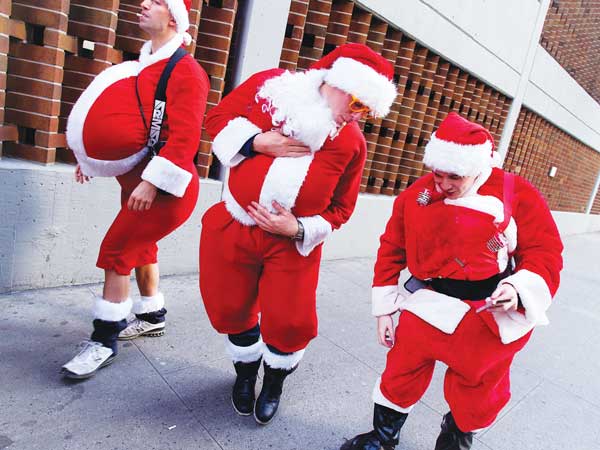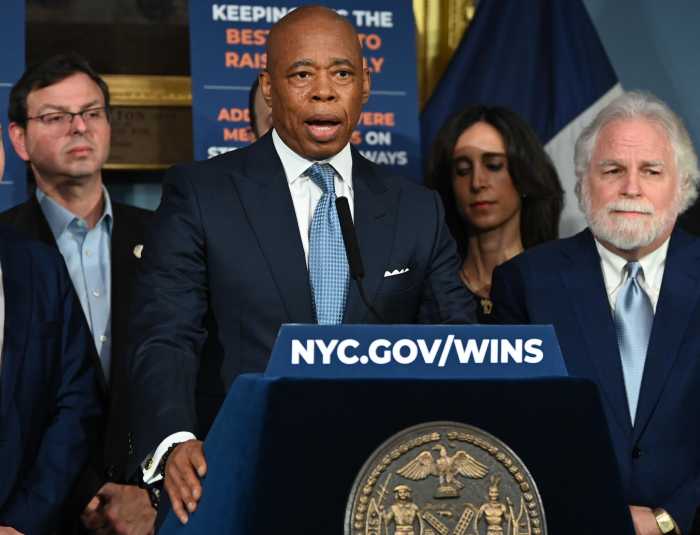BY DIEM BOYD | The cataclysmic yearly event that Lower East Siders (and much of New York City) have come to dread, SantaCon, did not get here on its own. It’s simply a natural outgrowth of the unbridled expansion of New York University and the ferocious lobbying efforts in Albany, which promoted alcohol as the way to “save” our “blighted” neighborhoods.
As nearly every available storefront is now liquor-licensed, the promise of sustained long-term economic growth, an improvement in quality of life and public health and a reduction in crime has unfortunately turned out to be one large, cruel joke. Our streets are not significantly cleaner, our schools are not significantly better, the hard drugs are still here (with heroin making a comeback among the white middle class), homelessness is at record-high levels, and overall crime has not precipitously dropped with our neighborhoods awash in alcohol.
Research has shown that neighborhoods with high alcohol density — irrespective of economic, ethnic or age demographics — simply have more crime. While there was a drastic drop in crime citywide in the mid-’90s, there have only been modest reductions since 1998 in the Lower East Side’s Seventh Precinct. Most disturbing is the fact that rape — a violent felony that is causally linked to alcohol — has actually increased in alcohol-saturated Hell’s Square, up from zero in 2013 to three in 2014 year to date, accounting for nearly 50 percent of rapes reported in the Seventh Precinct.
Meanwhile, felony assaults, which are also often fueled by alcohol, have leapt by 33.3 percent so far in 2014, with 129 this year in the Seventh versus 97 at the same point last year.
Hell Square’s tiny, densely liquor-saturated land area covers just 4.2 percent of the Seventh Precinct’s jurisdiction. Yet in 2013 the area was the location of a disproportionate 28 percent of major crimes in the precinct. This trend continued through October 2014.
This small square’s double burden is that, first, it has been inflicted with a concentration of the worst crimes seen in the Seventh Precinct (rape, felony assault, grand larceny and burglary), and, second, that it must somehow survive the assault on quality of life that has rendered the area nearly unlivable for the thousands of residential tenants and apartment owners along Ludlow, Orchard, Stanton, Rivington, Essex, Houston, Delancey and Allen Sts.
With New York State Liquor Authority licensing fees and fines income generating the second-largest agency revenue stream for Albany, New York City in general and Hell Square in particular are essentially picking up the tab for the rest of the state. Albany fills its coffers benefitting New York State at large at the grossly disproportionate expense of tiny liquor-saturated communities like Hell Square. Undoubtedly, those living outside of New York City would never allow their communities to suffer the blight of densely oversaturated liquor zoning, nor the havoc of a SantaCon march binge-drinking its way through their communities.
Like Albany, SantaCon organizers cite the ostensible economic benefit of alcohol consumption at local watering holes as the key argument in support of the event’s existence. In reality, though, the extremely narrow economic benefit limited to the types of bars and fast-food joints serving SantaCon exists at the enormous cost of a community stripped bare of all diversity.
SantaCon is simply a grotesque manifestation of displacement, where the overwhelming dominance of alcohol-outlet density has supplanted residents, small businesses and local services. People and local-friendly businesses, including mom-and-pop restaurants and bars, disappear; they are all unable to pay the staggering rents resulting from the dominance of large taverns and nightclubs (including those within hotels) that are primarily devoted to drinking, with emphasis on binge-drinking, bottle service and drink specials. These businesses have a monopoly that can undercut traditional bars and restaurants, given their lower product and distribution costs.
SantaCon, the massive pub crawl attracting the fraternity crowd of overwhelmingly white, suburban, non-hipster 20-somethings, feeds into this economic model. With a city drowning in bars, there is no shortage of SantaCon-friendly options blasting middle-brow commercial music, under the glow of too many similarly blasting TV’s, with a narrow selection of cheap beers and two-for-one shots for the congregation of Santas ready to binge drink for 12 hours.
Unfortunately, the incidence of binge drinking on the Lower East Side and in the East Village — as seen in SantaCon — is skyrocketing and shows no signs of abating.
Consider that, according to the Centers for Disease Control, excessive drinking and binge drinking cost the U.S. $223.5 billion — or $1.90 a drink — in 2006 due to losses in productivity, healthcare, crime and other expenses. The cost to federal, state and local governments is roughly 62 cents per drink, while federal and state income taxes on alcohol totaled only about 12 cents per drink (“CDC Fact Sheet: Binge Drinking,” Jan. 16, 2014).
SantaCon may be a once-a-year event. Yet it stands as the poster child for years of poor and often corrupt economic decision making, with no foresight, vision or concern for livable, balanced communities. The primary purpose of government is to secure the health, safety and peaceful security of all citizens regardless of where they live. This function has been abrogated when, in the total absence of any civic control, any given community becomes a kind of unlivable Wild West dumping ground for out-of-control binge drinking and the litany of negatives that follow on its tail.
Such is the reality of Hell Square, Lower East Side, New York City. The time for action is long overdue.
Boyd is founder, LES Dwellers




































